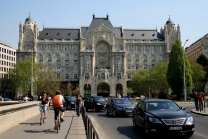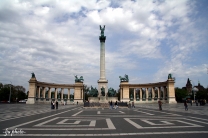No video yet
St. Stephen's Basilica
St. Stephen's Basilica (Hungarian: Szent István-bazilika, Hungarian pronunciation: [ˈsɛnt ˈiʃtvaːn ˈbɒzilikɒ]) is a Roman Catholic basilica in Budapest, Hungary. It is named in honour of Stephen, the first King of Hungary (c 975–1038), whose supposed right hand is housed in the reliquary. It was the sixth largest church building in Hungary before 1920. Since the renaming of the primatial see, it's the co-cathedral of the Roman Catholic Archdiocese of Esztergom-Budapest. Today, it is the third largest church building in present-day Hungary.
Architecture
The site of today's basilica was a theater in the 18th century. This theater, named Hetz-Theater, was a place where animal fights were hosted. One of the wealthy citizens (Zitterbarth János) of the newly formed district built a temporary church there. In the late 1810s, about a few hundred people formed the Lipótváros Parish. Then they began the fundraising and the believers started to make plans for the future church.
The church is named after Saint Stephen I of Hungary, the first King of Hungary (c. 975–1038), whose "incorruptible" right hand is said to be housed in the reliquary.
This is the most important church building in Hungary, one of the most significant tourist attractions and the third highest church in Hungary.
Equal with the Hungarian Parliament Building, it is one of the two tallest buildings in Budapest at 96 metres (315 ft) - this equation symbolises that worldly and spiritual thinking have the same importance. Current regulations prohibit the construction of any building taller than 96 metres (315 ft) in Budapest. It has a width of 55 metres (180 ft), and length of 87.4 metres (287 ft). It was completed in 1905 after 54 years of construction, according to the plans of Miklós Ybl, and was completed by József Kauser. Much of this delay can be attributed to the collapse of the dome in 1868 which required complete demolition of the completed works...









